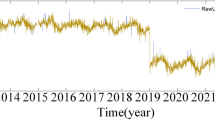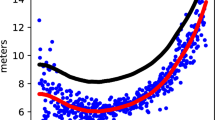Abstract
This paper deals with the basic definitions and the numerical techniques used nowaday in the estimation of the gradiometric geoid. After a first introductory paragraph, the so-called 3-steps remove/restore method is presented. The computation and the use of global models is analysed in Section 2; the computation of topographic corrections, with particular care to the residual terrain correction, is presented in Section 3; the central solution or estimation of the anomalous potential either by solving a Molodensky's problem, or by applying the collocation theory, is examined in Section 4; the restore step is finally presented in Section 5.
Similar content being viewed by others
References
Jekeli C.: 1988, ‘The Exact Transformation Between Ellipsoidal and Spherical Harmonic Expansion’,Man. Geod. 13(2).
Heck, B.: 1991, ‘On the Linearized Boundary Value Problems of Physical Geodesy’, OSU Report N. 407, February 1991.
Heiskanen, W. A. and Moritz, H.: 1981,Physical Geodesy, Repr. Inst. of Physical Geodesy TUG, Graz.
Moritz, H.: 1980,Advanced Physical Geodesy, H. Wichmann Verlag, Karlsruhe.
Rapp, R. H.: 1989, ‘Combination of Satellite, Altimetric and Terrestrial Gravity Data’, inTheory of Satellite Geodesy and Gravity Field Determination, Lecture Notes in Earth Science. Springer Verlag.
Rapp, R. H. and Pavlis, N. K.: 1990, ‘The Development and Analysis of Geopotential Coefficient Models to Spherical Harmonic Degree 360’,Jour. of Geophysical Research,95(13), Dec. 10.
Sacerdote, F. and Sansò, F.: 1991, ‘Spectral Calculus and Moving Average Operators on the Sphere’, Contribution to Geodetic Theory and Methodology, IAG Sect IV Report, XX Gen. Assembly of IUGG, Vienna.
Sansò, F., Barzaghi, R. and Tscherning, C. C.: 1986, ‘Choice of Norm for the Density Distribution of the Earth’,Geophys. J.R. astr. Soc. 87(1).
Sansò, F.: 1986, Statistical Methods in Physical Geodesy’, inMathematical and Numerical Techniques in Physical Geodesy. Lecture Notes in Earth Sciences N. 7, (H. Sünkel (ed.)) Springer Verlag.
Schwarz, K. P., Sideris, M. G. and Forsberg, R.: 1990, ‘The Use of FFT Techniques in Physical Geodesy’,Geophy. Jour. International N. 100.
Thong, N. C. and Grafarend, E. W.: 1989, ‘A Spheroidal Harmonic Model of the Terrestrial Gravitational Field’,Man. Geod.,14(5).
Tscherning, C. C. and Rapp, R. H.: 1974, ‘Closed Covariance Function Expressions for Gravity Anomalies, Geoid Undulations and Deflections of the Vertical Implied by Anomaly Degree Variance Models’, O.S.U. Report N. 208, Columbus.
Wieser, M.: 1987, Das globale digitale Höhenmodell TUG 87; Inter. Bericht der Ab.f.Mat. und Datenverarbeitende Geod. TUG, Graz.
Author information
Authors and Affiliations
Rights and permissions
About this article
Cite this article
Sansò, F., Sona, G. The challenge of computing the geoid in the nineties. Surv Geophys 14, 339–371 (1993). https://doi.org/10.1007/BF00690564
Received:
Issue Date:
DOI: https://doi.org/10.1007/BF00690564




